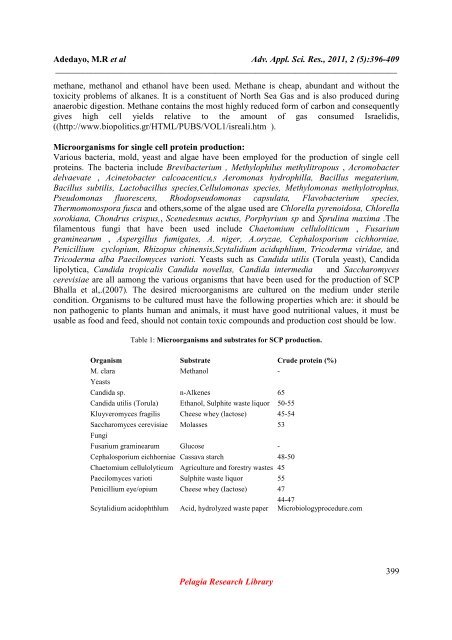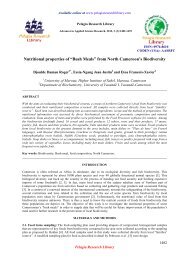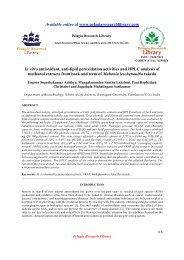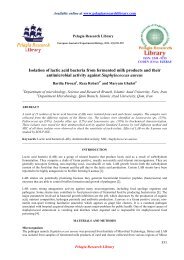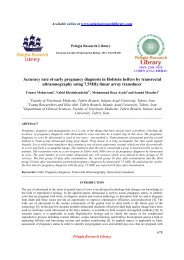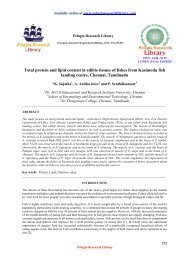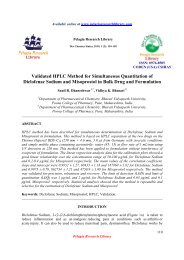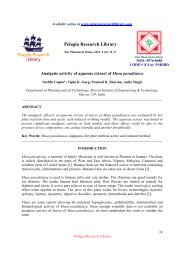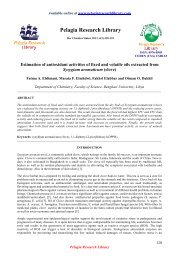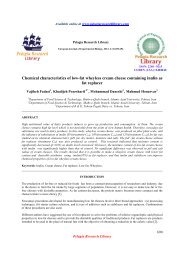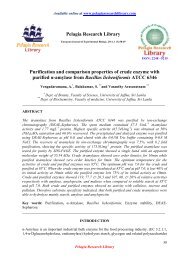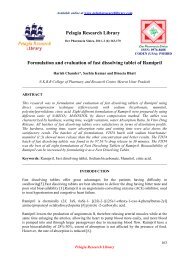Single Cell Proteins: As Nutritional Enhancer. - Pelagia Research ...
Single Cell Proteins: As Nutritional Enhancer. - Pelagia Research ...
Single Cell Proteins: As Nutritional Enhancer. - Pelagia Research ...
Create successful ePaper yourself
Turn your PDF publications into a flip-book with our unique Google optimized e-Paper software.
Adedayo, M.R et al Adv. Appl. Sci. Res., 2011, 2 (5):396-409<br />
_____________________________________________________________________________<br />
methane, methanol and ethanol have been used. Methane is cheap, abundant and without the<br />
toxicity problems of alkanes. It is a constituent of North Sea Gas and is also produced during<br />
anaerobic digestion. Methane contains the most highly reduced form of carbon and consequently<br />
gives high cell yields relative to the amount of gas consumed Israelidis,<br />
((http://www.biopolitics.gr/HTML/PUBS/VOL1/isreali.htm ).<br />
Microorganisms for single cell protein production:<br />
Various bacteria, mold, yeast and algae have been employed for the production of single cell<br />
proteins. The bacteria include Brevibacterium , Methylophilus methylitropous , Acromobacter<br />
delvaevate , Acinetobacter calcoacenticu,s Aeromonas hydrophilla, Bacillus megaterium,<br />
Bacillus subtilis, Lactobacillus species,<strong>Cell</strong>ulomonas species, Methylomonas methylotrophus,<br />
Pseudomonas fluorescens, Rhodopseudomonas capsulata, Flavobacterium species,<br />
Thermomonospora fusca and others,some of the algae used are Chlorella pyrenoidosa, Chlorella<br />
sorokiana, Chondrus crispus,, Scenedesmus acutus, Porphyrium sp and Sprulina maxima .The<br />
filamentous fungi that have been used include Chaetomium celluloliticum , Fusarium<br />
graminearum , <strong>As</strong>pergillus fumigates, A. niger, A.oryzae, Cephalosporium cichhorniae,<br />
Penicillium cyclopium, Rhizopus chinensis,Scytalidium aciduphlium, Tricoderma viridae, and<br />
Tricoderma alba Paecilomyces varioti. Yeasts such as Candida utilis (Torula yeast), Candida<br />
lipolytica, Candida tropicalis Candida novellas, Candida intermedia and Saccharomyces<br />
cerevisiae are all aamong the various organisms that have been used for the production of SCP<br />
Bhalla et al,.(2007). The desired microorganisms are cultured on the medium under sterile<br />
condition. Organisms to be cultured must have the following properties which are: it should be<br />
non pathogenic to plants human and animals, it must have good nutritional values, it must be<br />
usable as food and feed, should not contain toxic compounds and production cost should be low.<br />
Table 1: Microorganisms and substrates for SCP production.<br />
Organism Substrate Crude protein (%)<br />
M. clara Methanol -<br />
Yeasts<br />
Candida sp. n-Alkenes 65<br />
Candida utilis (Torula) Ethanol, Sulphite waste liquor 50-55<br />
Kluyveromyces fragilis Cheese whey (lactose) 45-54<br />
Saccharomyces cerevisiae Molasses 53<br />
Fungi<br />
Fusarium graminearum Glucose -<br />
Cephalosporium eichhorniae Cassava starch 48-50<br />
Chaetomium cellulolyticum Agriculture and forestry wastes 45<br />
Paecilomyces varioti Sulphite waste liquor 55<br />
Penicillium eye/opium Cheese whey (Iactose) 47<br />
44-47<br />
Scytalidium acidophthlum Acid, hydrolyzed waste paper Microbiologyprocedure.com<br />
<strong>Pelagia</strong> <strong>Research</strong> Library<br />
399


